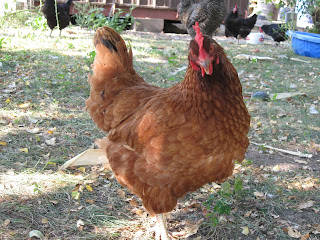When I first told my husband I wanted to raise bugs in my kitchen so that
my chickens had treats, he thought I was nuts. By this time I had jumped in
head first into the world of chickens. I had a chicken purse, a tshirt and I
was growing stuff for my chickens to eat. Which was very weird because I had
all but given up on growing anything because everytime I tried to grow
something, I killed it. But for my chickens, I tried again and got a whole
garden of things grown just for them. So as you can imagine, I told my husband
i needed some things to start growing worms and he of course was blown away.
Once I got my "worm farm" started though, he didn't think I was so
crazy.
First I want to say this. I have done A LOT of research and reading. I am
going to share with you what works for me. It is not the only way to do this.
There are many other ways. This way is just the best way that I have found to
do this.
Ok, so starting your worm farm is so easy to do. Its also pretty cheap. The
things you need to set up:
- a 28 quart clear tote
-a 56 quart clear tote
(note that the smaller one needs to nest inside the bigger one, see photo)
-an exacto knife
-a hot glue gun
- a piece off window screen big enough to cover the bottom of one tote
- a screw gun and a drill bit
First, take the smaller of the two totes, turn it upside down and cut out
the bottom, leaving about an inch lip to glue the window screen onto. I found that the easiest way to cut it out is
to not use much pressure and go over and over it with the knife. It will get
weaker and pop right out.
Once you have the hole cut, get your glue gun ready and glue the window
screen to the bottom. Try making it as tight as you can so that the screen wont
sag. Let it dry at least an hour so that
the hot glue isnt sticky.
Next, get one of the lids. You want to drill holes in it for air. I put
about 15 holes in mine, you can gauge about how many you need. They dont need
much air but you need some air to circulate in the boxes. I also hot glued a small piece of window screen on the inside of each hole to help prevent moths from entering the setup.
~~~~~~~~~~~~~~~~~~~~~~~~~~~~~~~~~~~
Setting up your worms and what you need -
- a jar of plain oats (not the instant kind)
- layer pellets, yes the ones for chickens
- a basket strainer
- a potato, carrot or celery stick.
- blender or food proccessor
Start with your layer pellets, you need to grind them up in your
blender/food processor. I actually use a knockoff of the Magic Bullet, I bought
it for $17 at walmart. Add the layer pellets in and grind them up. Get a big
bowl and sift the ground layer pellets into the bowl to get any big pieces out.
Make sure the bowl you use can be put in the microwave. Do this until you have a full bowl.
This next part is VERY important.
Are you listening? Place the bowl in the microwave and heat it up for 30-45
seconds. This will kill anything that may be living in the feed. I didnt do
this the first time I set up my mealworm farm and I ended up with grain mites.
They bite and they are very tiny! So make sure you do this!!!
Keep grinding them up until you have about 2.5 inches in the bottom of the
big tote, the one you didnt cut. Once you have them ground, heated and put in
your tote, add 2 cups of the oats to the tote and mix well. Now you are done
with the bottom set up!! Congrats!! Set the smaller tote inside the bigger
tote. Now you have created a sort of sifting system. In the top tote, add 2 cups of oatmeal.
Now, for the fun part. Worms!!! There are many places you can get your
initial worms from. I will put some links at the end of this post for you to
check out. I started my farm with 500
worms. I bought mine from the pet store at $3.50 per 100 of them. I could have
gotten them cheaper (and more of them) if I had ordered them online, but I have
a problem with instant gratification. Make sure that you start with MEALWORMS. Don't get confused and buy superworms. If
I had to do it again, I would have gotten about 3,000 mealworms to get started.
Once you get your worms, place them in the bottom tote with the oatmeal and
layer mash. You need to take your vegetable and cut it up into 2-3 pieces. Place
it in the tote with the worms. Humidity is important and the veggie helps with
that. The worms will eat the veggie along with the bedding they are in. Don't
let the veggie ever get moldy, so replace it every couple of days.
Keeping your worms-
The first part of your mealworm farm is the most time you will spend with
your farm the whole time you have it. The life cycle of the mealworm is very
simple:
Your worms will turn into these little alien things. They are called pupa.
They dont move much and they dont eat. I went a little crazy with checking on
my worms. I would do it multiple times a day because I was so excited to see
the change happen. So when you go through your bottom tote ( you can do it
every other day ) You put the pupa that you find into the top tote. They will
turn into beetles. Each femal beetle can lay up to 500 eggs in her short lifetime.
That is A LOT of worms. Its hard to wait on the worms to turn and the pupa to
turn and its a HUGE deal when you get your first beetle. Make sure that the top
tote has a veggie in it for the beetles.
The mealworm beetles are actually called darkling beetles. And they are
named well. The beetles love dark. They love having places to hide, so make
sure that you have some toilet paper rolls or some cut egg cartons. Give them
places to get under.
Im sure that you are wondering why you have a top tote that has window
screen on it. When the beetles lay their eggs, sometimes they can be a little
bit canabalistic. The window screen allows the eggs to fall through to the
bottom to join the worms. Therefore, beetles cant eat them.
That is about all you need to know about a mealworm farm! Its one big
cycle. The worms turn to pupa, then to beetles, they lay eggs that fall to the
bottom and turn into worms. Simple!
Things to do with your farm......
Name each worm. My kids did, well they tried.
Feed them to your chickens, they will follow you everywhere for a worm. Its
quite funny actually.
Freeze them! Click here to get instructions on how to freeze them for your
chickens.
Thats all I can think of really. There isnt much you can do with worms,
hahaha! They will save you a bunch of money and give you some really cool
entertainment watching the life cycle. I hope everyone sends me pictures when they start their own!
I want you to show off your worms!
Resources to buy worms online -














